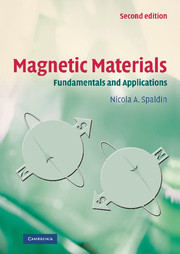Book contents
- Frontmatter
- Contents
- Acknowledgments
- I Basics
- 1 Review of basic magnetostatics
- 2 Magnetization and magnetic materials
- 3 Atomic origins of magnetism
- 4 Diamagnetism
- 5 Paramagnetism
- 6 Interactions in ferromagnetic materials
- 7 Ferromagnetic domains
- 8 Antiferromagnetism
- 9 Ferrimagnetism
- 10 Summary of basics
- II Magnetic phenomena
- III Device applications and novel materials
- Epilogue
- Solutions to selected exercises
- References
- Index
4 - Diamagnetism
from I - Basics
Published online by Cambridge University Press: 05 June 2012
- Frontmatter
- Contents
- Acknowledgments
- I Basics
- 1 Review of basic magnetostatics
- 2 Magnetization and magnetic materials
- 3 Atomic origins of magnetism
- 4 Diamagnetism
- 5 Paramagnetism
- 6 Interactions in ferromagnetic materials
- 7 Ferromagnetic domains
- 8 Antiferromagnetism
- 9 Ferrimagnetism
- 10 Summary of basics
- II Magnetic phenomena
- III Device applications and novel materials
- Epilogue
- Solutions to selected exercises
- References
- Index
Summary
A sensitive compass having a Bi needle would be ideal for the young man going west or east, for it always aligns itself at right angles to the magnetic field.
William H. Hayt Jr., Engineering Electromagnetics, 1958In the previous chapter we studied two contributions to the magnetic moment of atoms – the electron spin and orbital angular momenta. Next we are going to investigate the third (and final) contribution to the magnetic moment of a free atom. This is the change in orbital motion of the electrons when an external magnetic field is applied.
The change in orbital motion due to an applied field is known as the diamagnetic effect, and it occurs in all atoms, even those in which all the electron shells are filled. In fact diamagnetism is such a weak phenomenon that only those atoms which have no net magnetic moment as a result of their shells being filled are classified as diamagnetic. In other materials the diamagnetism is overshadowed by much stronger interactions such as ferromagnetism or paramagnetism.
Observing the diamagnetic effect
The diamagnetic effect can be observed by suspending a container of diamagnetic material, such as bismuth, in a magnetic field gradient, as shown in Fig. 4.1. Since diamagnetic materials exclude magnetic flux, their energy is increased by the presence of a field, and so the cylinder swings away from the high-field region, towards the region of lower field (the north pole in the figure).
Information
- Type
- Chapter
- Information
- Magnetic MaterialsFundamentals and Applications, pp. 38 - 47Publisher: Cambridge University PressPrint publication year: 2010
Accessibility standard: Unknown
Why this information is here
This section outlines the accessibility features of this content - including support for screen readers, full keyboard navigation and high-contrast display options. This may not be relevant for you.Accessibility Information
- 1
- Cited by
